Structural platinum market deficits will persist despite US tariffs and associated GDP risks
10 April 2025
The United States’s imposition of wide ranging and onerous tariffs on trading partners risks pushing the global economy into a recession or, at the very least, slowing GDP growth. Assessing the downside risks for platinum demand, we have used the supply chain disruptions of 2021/22 as a point of reference where platinum demand was its lowest in our time series. Positively, our conclusion is that structural demand changes, such as platinum for palladium substitution in catalytic converters, mitigate downside scenario risks and limit platinum demand reduction to ~400 koz. This is insufficient to eliminate the embedded deficit of 848 koz forecast for 2025.
The US’s announcement of a 10% baseline tariff on imports and the now deferred country specific tariffs has been accompanied by downgrades to global growth forecasts. Fitch Global GDP growth is now forecast at 2.3% in 2025 compared to 2.6% in December 2024. Moreover, over the course of the past week, J.P.Morgan rapidly and progressively increased its estimate of global recession risk from 15% to 60%. Around 90% of annual platinum demand is tied to automotive, jewellery and other industrial sectors. Between 2013 to 2023, platinum demand growth within these markets has shown a high correlation with global GDP growth at 0.8 (Fig. 1).
Figure 1. Platinum demand growth is correlated to GDP
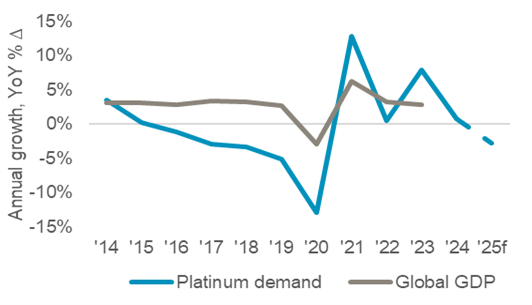
Figure 2. Platinum should remain in deficit despite risks
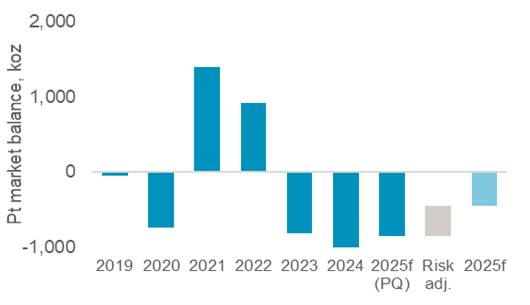
Our March 2025 Platinum Quarterly (link), forecast that annual platinum demand will decrease by -2.8% YoY this year. Although platinum end-uses are diverse, the broader than expected scope of tariff announcements warrants further evaluation of downside risks to demand. In our time series from 2013, platinum demand troughed in 2021 and 2022 at below 7.0 Moz largely due to COVID related global supply chain challenges. While this may present similarities to the trade disruption which steep US tariffs could cause, there are key differences between 2021/22 and now. Firstly, our analysis of a 25% tariff on US vehicle imports suggests lost sales of ~1.7 M units (Fig. 5) or 70 koz of platinum (link) and not the 10-15 M units p.a. of vehicle losses in 2021/22. Moreover, platinum for palladium automotive substitution of ~800 koz is now entrenched in demand. Secondly, the downside risks to industrial demand in 2025f may be limited to only ~100 koz (Fig. 6) given a) a stable growth track record, b) that we are already forecasting demand at a five-year low in 2025, and c) capacity additions being largely committed to for 2025 (any industrial demand downturn is likely 2026 or beyond). Finally, jewellery demand troughed at 1.83 Moz (Fig. 7) at 200 koz below our 2025f demand forecast of 2.03 Moz. It is notable that comparing the demand trough during COVID ignores that there was no retail footfall or weddings then, and that platinum jewellery is now priced at parity to white gold (link).
Cumulatively the downside risks to platinum demand could reach ~400 koz (5% of total demand) versus our current forecasts. However, this is insufficient to eliminate the 2025 platinum market deficit of 848 koz.
Platinum’s attraction as an investment asset arises from:
- WPIC research indicates that the platinum market entered a period of consecutive supply deficits from 2023 and these are expected to fully deplete above ground stocks by 2029f
- Platinum supply remains challenged, both in terms of primary mining and secondary recycling supply
- Trade tensions are distorting market flows and accelerating market tightening
- Platinum is a critical mineral in the global energy transition underpinning a key role in the hydrogen economy
- The platinum price remains historically undervalued and significantly below the price of gold
Figure 3: Platinum’s annual demand in 2024 (8.3 Moz) was diversified, amongst automotive, jewellery, industrial and investment end markets

Figure 4: While North America only accounted for 19% of total platinum demand in 2024 (8.3 Moz), US tariffs are likely to be globally consequential

Figure 5: US vehicles sales volumes are correlated to prices which suggests tariffs will impact demand
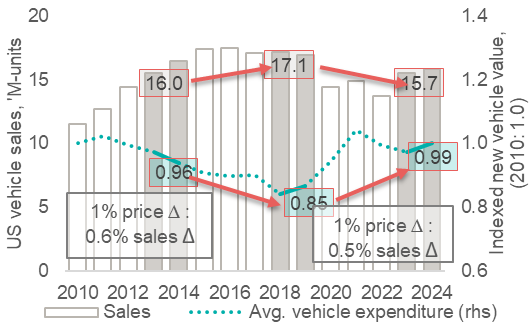
Figure 6: Reasonable downsides to industrial Pt demand appears already factored into 2025 forecasts

Figure 7: Pt jewellery demand troughed during COVID in 2020 which was 0.2 Moz less than our 2025f demand forecast
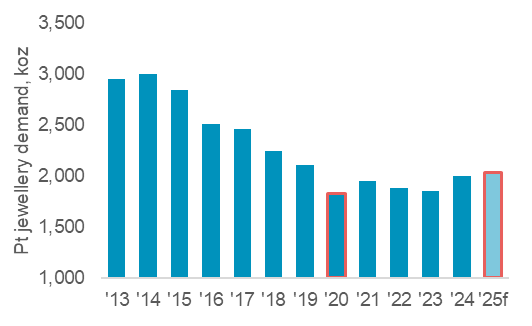
Figure 8: Downside risks within key demand segments are unlikely to cause expected 2025f platinum market deficits to move close to balanced
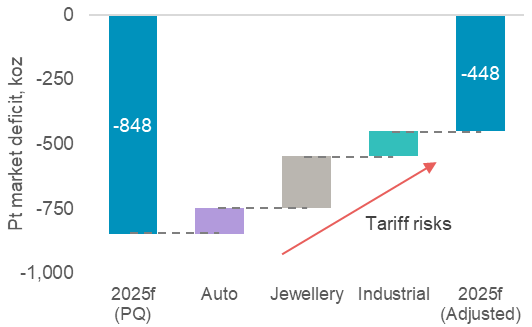
IMPORTANT NOTICE AND DISCLAIMER: This publication is general and solely for educational purposes. The publisher, The World Platinum Investment Council, has been formed by the world’s leading platinum producers to develop the market for platinum investment demand. Its mission is to stimulate investor demand for physical platinum through both actionable insights and targeted development: providing investors with the information to support informed decisions regarding platinum; working with financial institutions and market participants to develop products and channels that investors need.
This publication is not, and should not be construed to be, an offer to sell or a solicitation of an offer to buy any security. With this publication, the publisher does not intend to transmit any order for, arrange for, advise on, act as agent in relation to, or otherwise facilitate any transaction involving securities or commodities regardless of whether such are otherwise referenced in it. This publication is not intended to provide tax, legal, or investment advice and nothing in it should be construed as a recommendation to buy, sell, or hold any investment or security or to engage in any investment strategy or transaction. The publisher is not, and does not purport to be, a broker-dealer, a registered investment advisor, or otherwise registered under the laws of the United States or the United Kingdom, including under the Financial Services and Markets Act 2000 or Senior Managers and Certifications Regime or by the Financial Conduct Authority.
This publication is not, and should not be construed to be, personalized investment advice directed to or appropriate for any particular investor. Any investment should be made only after consulting a professional investment advisor. You are solely responsible for determining whether any investment, investment strategy, security or related transaction is appropriate for you based on your investment objectives, financial circumstances and risk tolerance. You should consult your business, legal, tax or accounting advisors regarding your specific business, legal or tax situation or circumstances.
The information on which this publication is based is believed to be reliable. Nevertheless, the publisher cannot guarantee the accuracy or completeness of the information. This publication contains forward-looking statements, including statements regarding expected continual growth of the industry. The publisher notes that statements contained in the publication that look forward in time, which include everything other than historical information, involve risks and uncertainties that may affect actual results. The logos, services marks and trademarks of the World Platinum Investment Council are owned exclusively by it. All other trademarks used in this publication are the property of their respective trademark holders. The publisher is not affiliated, connected, or associated with, and is not sponsored, approved, or originated by, the trademark holders unless otherwise stated. No claim is made by the publisher to any rights in any third-party trademarks
WPIC Research MiFID II Status
The World Platinum Investment Council -WPIC- has undertaken an internal and external review of its content and services for MiFID II. As a result, WPIC highlights the following to the recipients of its research services, and their Compliance/Legal departments:
WPIC research content falls clearly within the Minor Non-Monetary Benefit Category and can continue to be consumed by all asset managers free of charge. WPIC research can be freely shared across investment organisations.
- WPIC does not conduct any financial instrument execution business. WPIC does not have any market making, sales trading, trading or share dealing activity. (No possible inducement).
- WPIC content is disseminated widely and made available to all interested parties through a range of different channels, therefore qualifying as a “Minor Non-Monetary Benefit” under MiFID II (ESMA/FCA/AMF). WPIC research is made freely available through the WPIC website. WPIC does not have any permissioning requirements on research aggregation platforms.
- WPIC does not, and will not seek, any payment from consumers of our research services. WPIC makes it clear to institutional investors that it does not seek payment from them for our freely available content.
More detailed information is available on the WPIC website:
https://www.platinuminvestment.com/investment-research/mifid-ii
Contacts:
Edward Sterck, Research, [email protected]
Wade Napier, Research, [email protected]
Kaitlin Fitzpatrick-Spacey, Research, [email protected]
Brendan Clifford, Head of Institutional Distribution, [email protected]
WPIC does not provide investment advice.
Please see disclaimer for more information.
